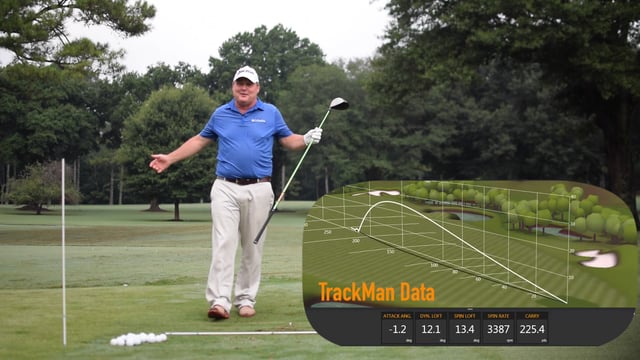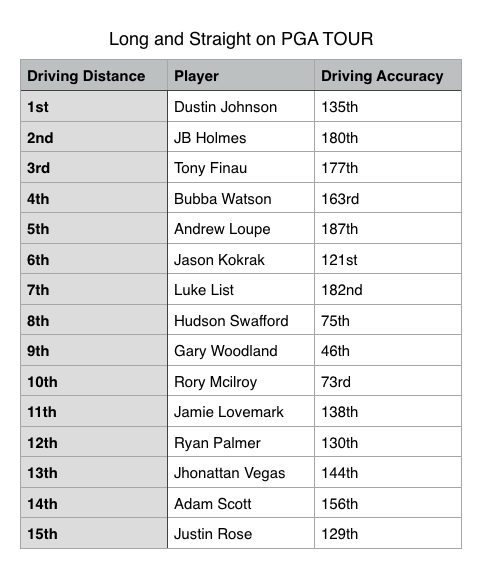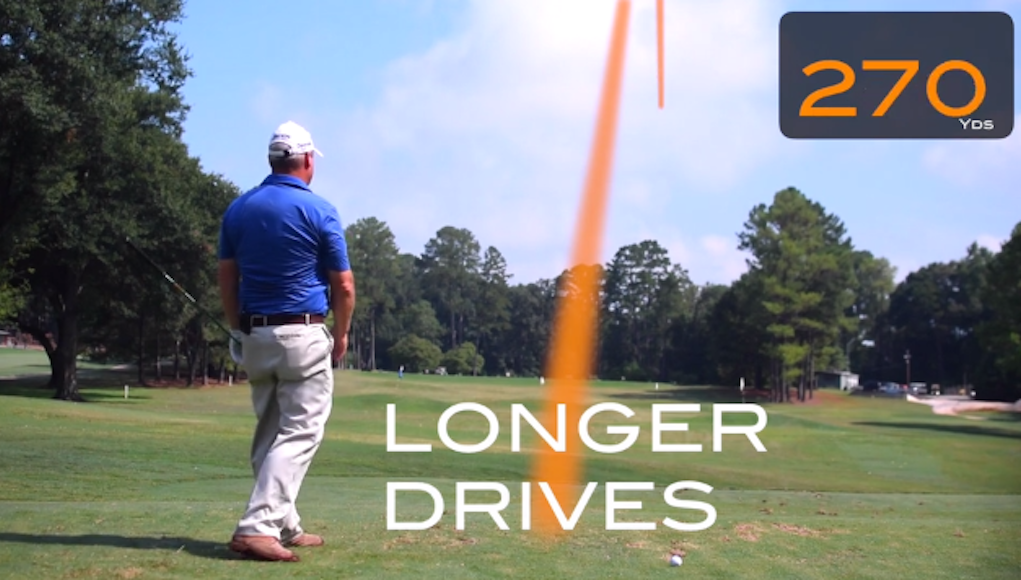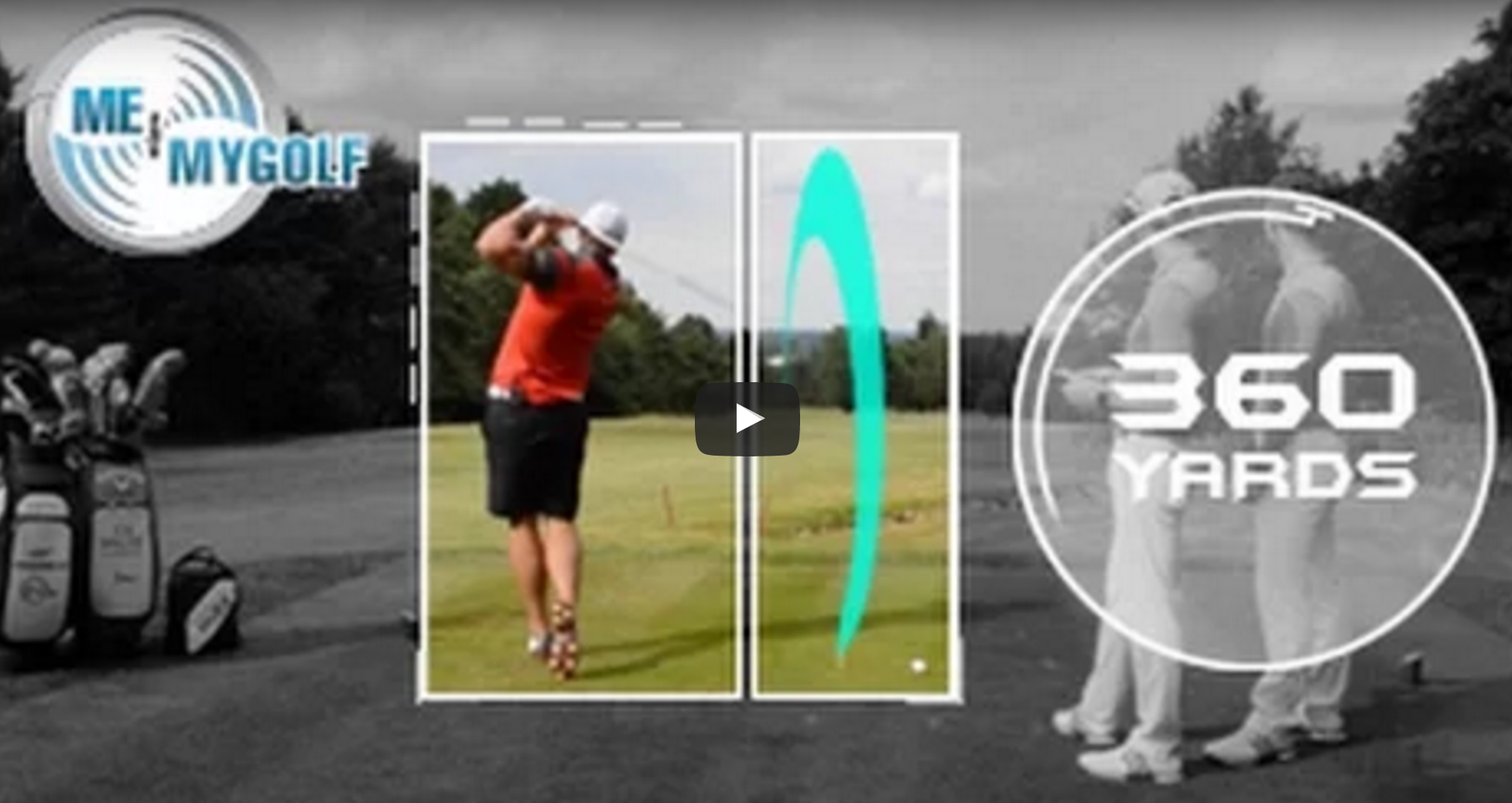Instruction
All golfers need a go-to shot with the driver

Go-To Driver from OnTour Golf on Vimeo.
The author, Scott Hamilton is known for helping golfers achieve distance and accuracy with their driver. Go here to watch a lesson that helped a student gained 80 yards on his driver and get free access to his “Before Your Next Tee Shot” Course on OnTOURGolf.com
It doesn’t take a genius to recognize that being long and straight off the tee is what every golfer is after. Obviously, anyone who can do that with consistency has an advantage. What most people don’t realize is that it’s tough to be both long and straight.
When you’re long, small mistakes at impact are magnified by how far the ball travels. A shot hit 1-degree offline gets farther from the target-line the farther it goes. Because of this, the longest players on the PGA Tour don’t usually rank very high in driving accuracy… like not in the top 150! For example, Dustin Johnson is 1st in driving distance but 135th in accuracy. Bragging a little, my client Hudson Swafford is an exception. He is 7th in Driving Distance and 75th in Driving Accuracy (we’re working on his wedges now).

My point is long and straight don’t happen together very often. The chart above would lead you to believe, as a rule of thumb, that if you had to choose between long and straight you should choose long every time. Looking at the names on the chart above would only seem to make that point even clearer.
There are exceptions to that rule. All those partial strokes you gain with long drives on some holes can be quickly erased by a penalty from a shot hit out of bounds or into the water. That’s why learning to have a go-to shot with your driver on holes that bring penalty strokes into play is a must. If you haven’t already, watch the video at the top of this story to learn more.
Instruction
The Wedge Guy: Beating the yips into submission

There may be no more painful affliction in golf than the “yips” – those uncontrollable and maddening little nervous twitches that prevent you from making a decent stroke on short putts. If you’ve never had them, consider yourself very fortunate (or possibly just very young). But I can assure you that when your most treacherous and feared golf shot is not the 195 yard approach over water with a quartering headwind…not the extra tight fairway with water left and sand right…not the soft bunker shot to a downhill pin with water on the other side…No, when your most feared shot is the remaining 2- 4-foot putt after hitting a great approach, recovery or lag putt, it makes the game almost painful.
And I’ve been fighting the yips (again) for a while now. It’s a recurring nightmare that has haunted me most of my adult life. I even had the yips when I was in my 20s, but I’ve beat them into submission off and on most of my adult life. But just recently, that nasty virus came to life once again. My lag putting has been very good, but when I get over one of those “you should make this” length putts, the entire nervous system seems to go haywire. I make great practice strokes, and then the most pitiful short-stroke or jab at the ball you can imagine. Sheesh.
But I’m a traditionalist, and do not look toward the long putter, belly putter, cross-hand, claw or other variation as the solution. My approach is to beat those damn yips into submission some other way. Here’s what I’m doing that is working pretty well, and I offer it to all of you who might have a similar affliction on the greens.
When you are over a short putt, forget the practice strokes…you want your natural eye-hand coordination to be unhindered by mechanics. Address your putt and take a good look at the hole, and back to the putter to ensure good alignment. Lighten your right hand grip on the putter and make sure that only the fingertips are in contact with the grip, to prevent you from getting to tight.
Then, take a long, long look at the hole to fill your entire mind and senses with the target. When you bring your head/eyes back to the ball, try to make a smooth, immediate move right into your backstroke — not even a second pause — and then let your hands and putter track right back together right back to where you were looking — the HOLE! Seeing the putter make contact with the ball, preferably even the forward edge of the ball – the side near the hole.
For me, this is working, but I am asking all of you to chime in with your own “home remedies” for the most aggravating and senseless of all golf maladies. It never hurts to have more to fall back on!
Instruction
Looking for a good golf instructor? Use this checklist

Over the last couple of decades, golf has become much more science-based. We measure swing speed, smash factor, angle of attack, strokes gained, and many other metrics that can really help golfers improve. But I often wonder if the advancement of golf’s “hard” sciences comes at the expense of the “soft” sciences.
Take, for example, golf instruction. Good golf instruction requires understanding swing mechanics and ball flight. But let’s take that as a given for PGA instructors. The other factors that make an instructor effective can be evaluated by social science, rather than launch monitors.
If you are a recreational golfer looking for a golf instructor, here are my top three points to consider.
1. Cultural mindset
What is “cultural mindset? To social scientists, it means whether a culture of genius or a culture of learning exists. In a golf instruction context, that may mean whether the teacher communicates a message that golf ability is something innate (you either have it or you don’t), or whether golf ability is something that can be learned. You want the latter!
It may sound obvious to suggest that you find a golf instructor who thinks you can improve, but my research suggests that it isn’t a given. In a large sample study of golf instructors, I found that when it came to recreational golfers, there was a wide range of belief systems. Some instructors strongly believed recreational golfers could improve through lessons. while others strongly believed they could not. And those beliefs manifested in the instructor’s feedback given to a student and the culture created for players.
2. Coping and self-modeling can beat role-modeling
Swing analysis technology is often preloaded with swings of PGA and LPGA Tour players. The swings of elite players are intended to be used for comparative purposes with golfers taking lessons. What social science tells us is that for novice and non-expert golfers, comparing swings to tour professionals can have the opposite effect of that intended. If you fit into the novice or non-expert category of golfer, you will learn more and be more motivated to change if you see yourself making a ‘better’ swing (self-modeling) or seeing your swing compared to a similar other (a coping model). Stay away from instructors who want to compare your swing with that of a tour player.
3. Learning theory basics
It is not a sexy selling point, but learning is a process, and that process is incremental – particularly for recreational adult players. Social science helps us understand this element of golf instruction. A good instructor will take learning slowly. He or she will give you just about enough information that challenges you, but is still manageable. The artful instructor will take time to decide what that one or two learning points are before jumping in to make full-scale swing changes. If the instructor moves too fast, you will probably leave the lesson with an arm’s length of swing thoughts and not really know which to focus on.
As an instructor, I develop a priority list of changes I want to make in a player’s technique. We then patiently and gradually work through that list. Beware of instructors who give you more than you can chew.
So if you are in the market for golf instruction, I encourage you to look beyond the X’s and O’s to find the right match!
Instruction
What Lottie Woad’s stunning debut win teaches every golfer

Most pros take months, even years, to win their first tournament. Lottie Woad needed exactly four days.
The 21-year-old from Surrey shot 21-under 267 at Dundonald Links to win the ISPS Handa Women’s Scottish Open by three shots — in her very first event as a professional. She’s only the third player in LPGA history to accomplish this feat, joining Rose Zhang (2023) and Beverly Hanson (1951).
But here’s what caught my attention as a coach: Woad didn’t win through miraculous putting or bombing 300-yard drives. She won through relentless precision and unshakeable composure. After watching her performance unfold, I’m convinced every golfer — from weekend warriors to scratch players — can steal pages from her playbook.
Precision Beats Power (And It’s Not Even Close)
Forget the driving contests. Woad proved that finding greens matters more than finding distance.
What Woad did:
• Hit it straight, hit it solid, give yourself chances
• Aimed for the fat parts of greens instead of chasing pins
• Let her putting do the talking after hitting safe targets
• As she said, “Everyone was chasing me today, and managed to maintain the lead and played really nicely down the stretch and hit a lot of good shots”
Why most golfers mess this up:
• They see a pin tucked behind a bunker and grab one more club to “go right at it”
• Distance becomes more important than accuracy
• They try to be heroic instead of smart
ACTION ITEM: For your next 10 rounds, aim for the center of every green regardless of pin position. Track your greens in regulation and watch your scores drop before your swing changes.
The Putter That Stayed Cool Under Fire
Woad started the final round two shots clear and immediately applied pressure with birdies at the 2nd and 3rd holes. When South Korea’s Hyo Joo Kim mounted a charge and reached 20-under with a birdie at the 14th, Woad didn’t panic.
How she responded to pressure:
• Fired back with consecutive birdies at the 13th and 14th
• Watched Kim stumble with back-to-back bogeys
• Capped it with her fifth birdie of the day at the par-5 18th
• Stayed patient when others pressed, pressed when others cracked
What amateurs do wrong:
• Get conservative when they should be aggressive
• Try to force magic when steady play would win
• Panic when someone else makes a move
ACTION ITEM: Practice your 3-6 foot putts for 15 minutes after every range session. Woad’s putting wasn’t spectacular—it was reliable. Make the putts you should make.
Course Management 101: Play Your Game, Not the Course’s Game
Woad admitted she couldn’t see many scoreboards during the final round, but it didn’t matter. She stuck to her game plan regardless of what others were doing.
Her mental approach:
• Focused on her process, not the competition
• Drew on past pressure situations (Augusta National Women’s Amateur win)
• As she said, “That was the biggest tournament I played in at the time and was kind of my big win. So definitely felt the pressure of it more there, and I felt like all those experiences helped me with this”
Her physical execution:
• 270-yard drives (nothing flashy)
• Methodical iron play
• Steady putting
• Everything effective, nothing spectacular
ACTION ITEM: Create a yardage book for your home course. Know your distances to every pin, every hazard, every landing area. Stick to your plan no matter what your playing partners are doing.
Mental Toughness Isn’t Born, It’s Built
The most impressive part of Woad’s win? She genuinely didn’t expect it: “I definitely wasn’t expecting to win my first event as a pro, but I knew I was playing well, and I was hoping to contend.”
Her winning mindset:
• Didn’t put winning pressure on herself
• Focused on playing well and contending
• Made winning a byproduct of a good process
• Built confidence through recent experiences:
- Won the Women’s Irish Open as an amateur
- Missed a playoff by one shot at the Evian Championship
- Each experience prepared her for the next
What this means for you:
• Stop trying to shoot career rounds every time you tee up
• Focus on executing your pre-shot routine
• Commit to every shot
• Stay present in the moment
ACTION ITEM: Before each round, set process goals instead of score goals. Example: “I will take three practice swings before every shot” or “I will pick a specific target for every shot.” Let your score be the result, not the focus.
The Real Lesson
Woad collected $300,000 for her first professional victory, but the real prize was proving that fundamentals still work at golf’s highest level. She didn’t reinvent the game — she simply executed the basics better than everyone else that week.
The fundamentals that won:
• Hit more fairways
• Find more greens
• Make the putts you should make
• Stay patient under pressure
That’s something every golfer can do, regardless of handicap. Lottie Woad just showed us it’s still the winning formula.
FINAL ACTION ITEM: Pick one of the four action items above and commit to it for the next month. Master one fundamental before moving to the next. That’s how champions are built.
PGA Professional Brendon Elliott is an award-winning coach and golf writer. You can check out his writing work and learn more about him by visiting BEAGOLFER.golf and OneMoreRollGolf.com. Also, check out “The Starter” on RG.org each Monday.
Editor’s note: Brendon shares his nearly 30 years of experience in the game with GolfWRX readers through his ongoing tip series. He looks forward to providing valuable insights and advice to help golfers improve their game. Stay tuned for more Tips!












tom
Oct 9, 2016 at 11:57 am
I like his comment toward the end of the video of actually practicing the go to shot instead of hitting 6 iron at the range for hours and hours. Often I need to hit the go to driver shot he’s talking about and when I get up on the tee I am telling myself I should have actually practiced it more.
Patricknorm
Sep 23, 2016 at 8:26 am
You don’t play many tournaments or play for money in your weekly games. What shot shape are you confident of, when under pressure to ensure you’ll hit the fairway ? Sometimes your funny, many times well …… I’m a big fan of Scott Hamilton. I’m sure he’s given a variation of this advice to his stable of pros.
KK
Sep 25, 2016 at 3:16 pm
Sometimes? You’re being way too generous.
Straight-er
Sep 22, 2016 at 4:13 am
This chart for the Pros also indicates that the courses are way too forgiving for these long and inaccurate drivers to be able to win so much and make so much money from it. Sure they are also very powerful to be able to gouge it out of some heavier stuff, but it also indicates that there aren’t enough penalty boundaries and penalizing hazards and hazard lines on Tour that reins these guys in. It’s all for the entertainment on TV now, these courses they play that lets them just gouge it around; accuracy doesn’t matter that much, apparently.
KK
Sep 21, 2016 at 5:43 pm
A very useful go-to shot that almost no one has is the choked-down driver. Great off the first tee, tweener holes and for tight tee shots.
Oooh
Sep 23, 2016 at 3:19 am
Oooh yeah I like that punch driver shot. Very enjoyable. Feels good. Like a nice thrust up the straight and narrow
Progolfer
Sep 21, 2016 at 3:40 pm
Also, long and straight happen all the time!! Pro’s are missing fairways by inches and yards. Bad bounces, wind and firm conditions skew stats.
Progolfer
Sep 21, 2016 at 3:34 pm
Golfers don’t need a “go-to” shot. They need to practice properly, and get better. Everything else is just a band-aid.
Chris
Sep 21, 2016 at 4:00 pm
What are you talking about? If your stock shot is a fade or a draw then that’s your go to shot. This is exactly what the pros do. Patrick reed’s go to shot is a draw.. if it is tougher for certain player to hit a draw on a hole with the chance of a penalty than they prob should a fade or their go to shot..
KK
Sep 21, 2016 at 5:38 pm
Highly false. There are many kinds of driver shots just as there are many kinds of wedge shots.
mr b
Sep 21, 2016 at 1:40 pm
i’d like to have a budweiser with you sometime scott.
Dr Troy
Sep 21, 2016 at 11:03 am
Ran into Scott working with Steven Bowditch last weekend on the range here in GA. Such an easy going, likeable dude. Love listening to him talk about swing tips.
Mr. Wedge
Sep 21, 2016 at 11:00 am
Good article, couldn’t agree more. I’d take it a step further and say that your go-to shot doesn’t necessarily need to be with your driver. Take a 3-wood, or even hybrid. Most guys could hit a hybrid at least 210 and straight off the tee. Not often to people want to give up the distance potential, but it’s better than being 265 OB.
Scooter McGavin
Sep 21, 2016 at 5:07 pm
No, “most guys” couldn’t hit a hybrid 210 off the tee. The average golfer hits the driver 214 yards. That being said, I still agree with your point that there’s nothing wrong with a wood or hybrid being your safe shot from the tee. I had a round where none of my woods were feeling good, so I just hit 4 iron off the tee all day. Worked out pretty well.
Logical
Sep 22, 2016 at 8:50 pm
Playing devils advocate, I think he means “most guys” who are fairly serious about playing and scoring. Most of “those guys” can hit a hybrid 210.
KK
Sep 21, 2016 at 5:40 pm
I agree with Scooter. If you think most guys can go 210 with a hybrid, you don’t know most guys.
TheCityGame
Sep 22, 2016 at 10:06 am
Thing about that driver shot is is that for most guys, you’re going to avoid that crazy fat, or sky-ball shot. With a punch driver, bunt-cut, bunt-draw, low-laser. . . any golfer should at least be hitting the face on it.
If you can take a half-swing with a wedge, you can take a half-swing with a driver. Range that ish out. Bunt drive should be a more consistent shot than a full 4W.
Logical
Sep 22, 2016 at 8:53 pm
I don’t understand the first part of your statement, but the second seems valid. It’s very easy to hit a half driver, like your wedge, if you practice it a bit. Definitely can use that to trade distance for accuracy.